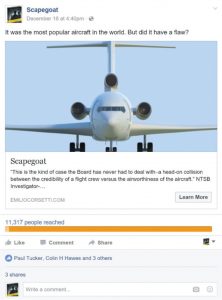PUBLISHED MAY 2017
by Emilio Corsetti III, Dlectronic Publishing Analyst

Emilio Corsetti III
The goal of this case study was simple: Can digital marketing increase book sales? I’ve used digital marketing to promote my books off and on for the last eight years. I have felt that those efforts have increased both visibility and sales, but I didn’t have any verifiable cause-and-effect evidence to support that assumption. In periods where I was engaged in digital marketing, sales increased; sometimes they flatlined. Other times, sales increases could be attributed to other efforts such as reviews, interviews, and traditional advertising.
What I needed was a way of measuring success based solely on digital marketing. That opportunity presented itself this past December. I am the author of two nonfiction books about aviation. My first book,
35 Miles from Shore: The Ditching and Rescue of ALM Flight 980, tells the true story of a 1970 airline ditching in the Caribbean Sea and the efforts to rescue those who survived. My second book,
Scapegoat: A Flight Crew’s Journey from Heroes to Villains to Redemption, tells the true story of an airline crew wrongly blamed for causing a near-fatal accident and the decades-long battle of the captain to clear his name. While the two stories have aviation as a common theme, there are few similarities between them. Both books, however, have a connection to the 2016 film
Sully starring Tom Hanks, which is about the ditching of US Air Flight 1549 in the Hudson River.
One of the techniques I’ve used in past digital marketing efforts involved comparison marketing: If you like this book, then you might also like this book. It’s the same as what Amazon does with customers by suggesting those who have bought one item also bought other items.
My book
Scapegoat was released in August 2016, and
Sully was released in the US that September. I invested heavily in digital marketing in September to coincide with the film’s release. I had very good sales in September. I also had a very positive review in an aviation publication, which probably added further influence along with my digital marketing efforts.
One gauge of success for me as an author has always been my Amazon sales ranking. I sell books through many different channels, but most of my sales as an independent author/publisher are through Amazon. Some say your Amazon sales ranking is not a reliable indicator of book sales, but my experience shows a direct correlation between sales ranking and sales on my publisher statements from my distributor (IPG). My Amazon ranking for my new book was doing well in the US, Canada, and Australia—my digital marketing efforts extended to those regions. The one region where I didn’t see any movement at all was
Amazon.co.uk.
When I learned that
Sully had a Dec. 2 release date in the UK, I decided to use that as an opportunity to do this case study. My measure for success was my Amazon sales ranking. If I could move the needle from its frozen spot of no sales, I would have some measure of proof that digital marketing works.
Bing
My digital marketing plan for the UK involved the following services: Google AdWords, Bing Ads, YouTube, and Facebook Advertising. I started to focus on the UK just after Thanksgiving. The plan was to have a slow ramp up to the film release date of Dec. 2. I started with some simple Bing ads. Below is an example of one of the ads I ran.

If someone entered a search term such as “Chesley Sullenberger” into a Bing search box, my ad would appear at the top of the search results. I won’t go into the details of running a Bing Ads campaign, but a few comments might be helpful. First, don’t expect to be able to learn the ins and outs of any digital marketing platform in a day or two. I had prior experience, and I spent a solid six months learning how to run a Google AdWords campaign. To be successful in digital marketing, you need to understand SEO, website design, keywords, bidding strategies, cost per click (CPC), bounce rates, analytics, campaign management, and much more. For example, one of my keyword phrases was “Clint Eastwood,” the director of
Sully. In checking the ad after a few weeks, I noticed several clicks on my ads after people had searched for Clint Eastwood westerns. I had to use negative keywords to prevent that from happening again. If you go into this without the basic knowledge and skills, you could easily spend more than you make in sales.
Second, Google invented the technology. They are the leaders. They are also much more expensive. The price you pay for a click on your ad is supposed to be based on an auction model. In theory, if you have no competition, you should be able to set your own price. How many other people are running ads with search terms based on the film
Sully? The answer is not that many. I expected to have a CPC of 30 cents or less. When I tried running the ads in Google AdWords, they didn’t run. Why? Because Google insisted on a starting bid price of over a $1.50 per click. That is too high for a book where I might make only $4 or $5 per sale. Those same ads on Bing ran for most keywords with a CPC of 30 cents or less per click. The average CPC was half that amount. I set a budget of $5 per day. I ran ads for both of my books. My total daily budget on Bing was $10 per day. The ads ran in the following regions: US, Canada, Australia, and the UK.
YouTube
The plan for YouTube was to promote my book trailer. The idea is similar to the Bing search campaign: If someone searches YouTube for content based on the film
Sully, my book trailer will appear in the search results. Additionally, I included keywords that were not related to the film, such as “accident investigations” and “airline accidents.”
I’ll say up front that you end up paying for a lot of tire kickers. They’ll watch 10 seconds, and then move on to something else. My book trailer contains a re-enactment of the rollover incident described in
Scapegoat. A good percentage of people who clicked on my video never went past the re-enactment, which takes up about one minute of a three-minute video. But, then again, my cost for each view averaged right around 3 cents per view. With a budget of $5 per day, that’s a lot of video views of my book trailer. My total views of the book trailer since uploading it in July of 2016 is around 15,000. My total spend for the entire life of the campaign was under $30.
Facebook

For Facebook, I decided to focus on the UK separately. I tried a combination of ads: video, still image, rotating images, website clicks, page likes, and boosted posts. For some of the ads, I restricted placement to desktop only. My feeling was that I wanted to draw people to my website where they could find additional information about this book as well as my first book. People clicking on an ad that shows up in their newsfeed on their mobile phone are unlikely to do much research once they get to my website.
On the left is an example of one of my Facebook ads for
Scapegoat.
You’ll notice that this ad has no connection to the film
Sully. Targeting in Facebook is not done by keywords, but instead by interest. So, while I did target people interested in Chesley Sullenberger, Tom Hanks, and Clint Eastwood, I placed a greater emphasis on interests such as airlines, nonfiction, Kindle, etc. I chose this ad as an example because it was my most successful ad. My total daily budget for all Facebook advertising, including ads that ran in the US, was $15 per day. The average CPC for this ad was just 4 cents per click. This one ad sent over 1,700 people to my website for a total cost of $67.
Remarketing
The goal in digital marketing is to gain visibility for a product or service through visits to your website—specifically, visits to a single page on your website. The bounce rate is the number of visitors who visit that single page and then leave the website without exploring further. A typical bounce rate for any digital marketing effort is going to be around 85 to 95 percent; that means only a small percentage of visitors are going to go beyond that one page. Using my Facebook example of 1,700 visitors and a bounce rate of 95 percent, that means that only 85 visitors explored more than the one page they landed on after clicking on my ad. But that’s 85 people who are expressing more than just a casual interest. What about the other 1,615 visitors? They, too, expressed an interest in the ad by clicking on it. Wouldn’t you like another crack at those visitors? Of course you do. That’s where remarketing comes into play.
Remarketing involves placing a cookie on the computer of the person visiting a web page. Once the cookie is on their computer, remarketing ads will display randomly to that person over a period of 30 days. They will display on websites that participate in Google’s AdSense program and other affiliated websites.
Below is an example of a remarketing ad for
Scapegoat.

Bing also offers the ability to run remarketing ads, but the number of websites set up to run those ads is limited. Once again, my budget for remarketing was $5 per day for Scapegoat, and another $5 per day for
35 Miles from Shore. The average CPC for my remarketing campaign in December was 64 cents per click. My total spend for both remarketing campaigns was under $50. Remarketing gives you that repeated exposure for pennies.
Results
Between the different platforms, my total liability for this digital marketing effort was $775, or $25 per day. But as you saw from the previous examples, I did not come close to that $25 a day limit, and that amount included digital marketing in the US, Canada, Australia, and the UK. But this case study was for the UK. I took a snapshot of my Amazon rankings for both books before the start of the campaign (See Figure 1 below). After running ads for a solid three weeks, I checked the rankings for both books in all formats. The results were disheartening. I hadn’t sold a single copy in any format. I was so disappointed that I pulled the Facebook ads for
Scapegoat in the UK. What’s the point, I figured? I’m losing money on a failed effort.
Maybe two days after I pulled the Facebook ads, I saw movement with the
35 Miles from Shore e-book. It went from well over 1 million in the ranking to under 100,000. I restarted the Scapegoat ads and committed to running the ads for the remainder of December.
Then, on Dec. 28, after not seeing any movement for
Scapegoat, I took the following snapshot:

I had the No. 5 book in commercial aviation in the UK. When I checked the ranking a few days before this, the sales ranking was north of 3,800,000. I moved the needle. I took a book with no media exposure whatsoever, in a region where I had little to no retail distribution, and turned it into a top-selling aviation title for under $500.
I can’t say at this point whether I made back my investment. I’ll continue to run the remarketing ads. I’m sure there were sales through other channels, and many of those early visitors may seek out the book in the future. But I can say that if you have the time and willingness to learn how to launch and manage a digital marketing campaign, it can increase both visibility and sales.
Emilio Corsetti III is a professional pilot and author. He has written for both regional and national publications, including the Chicago Tribune, Multimedia Producer,
and Professional Pilot magazine.